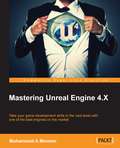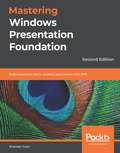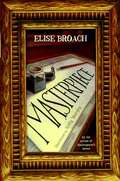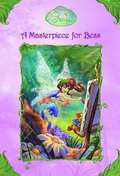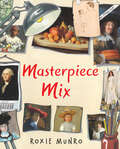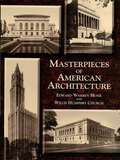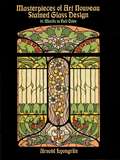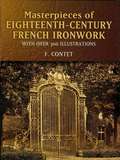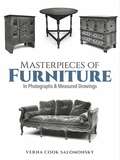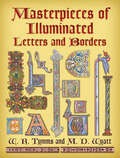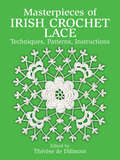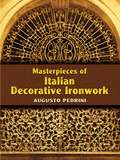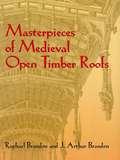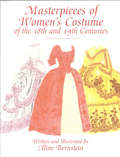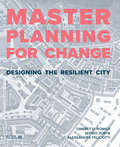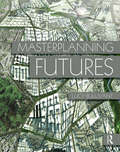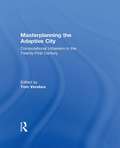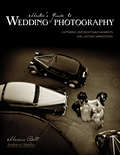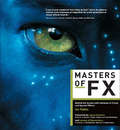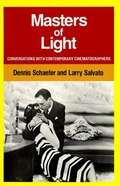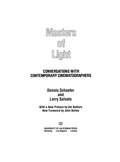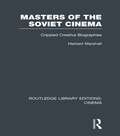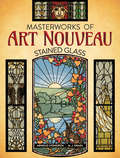- Table View
- List View
Mastering Unity Shaders and Effects
by Jamie DeanHarness the power of Unity 5 tools to write shaders and create stunning effects for next generation games About This Book * Leverage the power of Unity 5 compatible shaders to create a variety of realistic surfaces * Create amazing visual effects for your Unity 5.x games by blending advanced post-processing techniques and lighting effects * Add that extra visual edge to your games by learning pro level techniques Who This Book Is For This book is for users who are familiar with creating Unity projects and are looking for the next step to create stunning high-end visuals in their game project using the latest tools and features. You are expected to understand the creation of basic Unity projects, game object types, and scene navigation. You will need some basic programming experience in C# or JavaScript. What You Will Learn * Build your own custom shaders to suit a variety of organic and inorganic surfaces * Create amazing visual effects using Unity 5's improved toolset * Compare the advantages of Metallic and Specular workflows in Unity's Physically Based Lighting System * Take your Unity 5 project to the next level with advanced real-time and baked lighting methods * Design powerful particle effects * Find out how shaders, materials, and scripts work together within the Unity framework * Develop high-end and optimized game visuals suitable for mobile devices and other platforms In Detail With the inclusion of Physically Based Shading and the Standard Shader, Unity has changed the game for independent and large scale developers alike. Never before has it been so easy to create startling high quality visuals in games and other interactive projects. This book will give you a solid understanding of the interaction of shaders, lighting and effects in Unity 5, and give you some great ideas for how you can maximize the visual impact of your own games for PC, mobile and other platforms. In the sequence of chapters you will find solutions to some of the major challenges to the creation of responsive and realistic looking games. As you work on example scenes, you will get to know the syntax of ShaderLab and CG languages, creating simple and complex shader solutions for a variety of different surface effects. You will see how Unity's responsive lighting solutions can be harnessed to build immersive and appealing game experiences. Style and approach This is the most up-to-date resource on creating amazing visual effects for your Unity 5.x games. With the perfect mix of advanced techniques and their illustrations in real-world examples, this is the most comprehensive advanced guide on Unity shaders and effects you'll find.
Mastering Unreal Engine 4.X
by Muhammad A. MoniemTake your game development skills to the next level with one of the best engines on the market About This Book * Build an entire AAA game level throughout the book * Take your C++ scripting skills to the next level and use them extensively to build the game * An advanced practical guide with a tutorial style approach that will help you make the best of Unreal engine 4 Who This Book Is For This book is for game developers who have a basic knowledge of Unreal Engine and C++ scripting knowledge. If you want to take the leap from a casual game developer to a full-fledged professional game developer with Unreal Engine 4, this is the book for you. What You Will Learn * Script your player controls in C++ * Build a superb and engaging level with advanced design techniques * Program AI with C++ * Use Cascade to add life to your games * Use custom shaders and advanced shading techniques to make things pretty * Implement an awesome UI in the game * Control gameplay using data tables In Detail Unreal Engine 4 has garnered a lot of attention in the gaming world because of its new and improved graphics and rendering engine, the physics simulator, particle generator, and more. This book is the ideal guide to help you leverage all these features to create state-of-the-art games that capture the eye of your audience. Inside we'll explain advanced shaders and effects techniques and how you can implement them in your games. You'll create custom lighting effects, use the physics simulator to add that extra edge to your games, and create customized game environments that look visually stunning using the rendering technique. You'll find out how to use the new rendering engine efficiently, add amazing post-processing effects, and use data tables to create data-driven gameplay that is engaging and exciting. By the end of this book, you will be able to create professional games with stunning graphics using Unreal Engine 4! Style and approach An advanced guide that will take you to the next level of developing games with Unreal engine with illustrative examples that will make you confident of creating customized professional level games on your won.
Mastering Windows Presentation Foundation: Build responsive UIs for desktop applications with WPF, 2nd Edition
by Sheridan YuenGain the expertise you need to build custom application frameworks and responsive and visually appealing user interfaces with WPF, C#, and .NET Key Features Discover a smarter way of working with WPF using the MVVM software architectural pattern Create your own lightweight application framework to build your future applications upon Understand data binding and learn how to use it in an application Book Description Microsoft Windows Presentation Foundation (WPF) provides several libraries and APIs for developers to create engaging user experiences. This book features a wide range of simple through to complex examples to demonstrate how to develop enterprise-grade applications for Windows desktop with WPF. This updated second edition of Mastering Windows Presentation Foundation starts by covering the benefits of using the Model-View-ViewModel (MVVM) software architectural pattern with WPF, before guiding you through debugging your WPF apps. The book will then take you through the application architecture and building the foundation layer for your apps. As you advance, you'll get to grips with data binding, explore the various built-in WPF controls, and customize them to suit your requirements. You'll learn how to create custom controls to meet your needs when the built-in functionality is not enough. You'll also learn how to enhance your applications using practical animations, stunning visuals, and responsive data validation. To ensure that your app is not only interactive but also efficient, you'll focus on improving application performance, and finally, discover the different methods for deploying your applications. By the end of this book, you'll be proficient in using WPF for developing efficient yet robust user interfaces. What you will learn Discover MVVM and how it assists development with WPF Implement your own custom application framework Become proficient with Data Binding Understand how to adapt the built-in controls Get up to speed with animations Implement responsive data validation Create visually appealing user interfaces Improve application performance Learn how to deploy your applications Who this book is for This Windows book is for developers with basic to intermediate-level knowledge of Windows Presentation Foundation and for those interested in simply enhancing their WPF skills. If you're looking to learn more about application architecture and designing user interfaces in a visually appealing manner, you'll find this book useful.
Masterpiece
by Elise BroachIn this follow-up to "Shakespeare's Secret," Broach delivers a fast-paced mystery in which a young boy and a beetle attempt to pull off a staged art heist at the Metropolitan Museum of Art.
A Masterpiece for Bess
by Lara BergenFlattered at first that all the other fairies and sparrow men want her to paint their portraits, Bess soon begins to feel overwhelmed and tries to find a way to return to the kind of painting she really wants to do.
Masterpiece Mix
by Roxie Munro37 masterpieces inspire an artist in this introduction to art history that includes a search-and-find game. "Today I will make a new painting," declares an artist, but first she must build a stretcher to stretch the canvas; select which paints, brushes, and palette knives to use; and, most importantly, decide what to paint. Will she paint a still life in the style of Robert S. Duncanson or a portrait in the manner of Mary Cassatt? Using reproductions of art from the National Gallery of Art by Vincent van Gogh, Judith Leyster, Claude Monet and others pivotal figures in art history, Roxie Munroe introduces readers to a variety of iconic artists, art styles, and time periods. The sweeping painting she creates by the book's end cleverly incorporates all 37 pieces she has considered. Eagle-eyed readers will love finding the works of art in her painting and learning more about the artists in the notes in the back matter. You'll want to start building canvases and mixing colors for a masterpiece of your very own!
Masterpieces of American Architecture: Museums, Libraries, Churches and Other Public Buildings
by Willis Humphrey Church Edward Warren HoakFrom the golden age of American architecture comes this splendid survey, documenting scores of masterpieces built between 1900 and 1930. More than 260 illustrations include plans, sections, exterior and interior details, and photographs. A sampling of featured buildings include Lincoln Memorial, Boston Public Library, Tribune Tower, and Woolworth Building.
Masterpieces of Art Nouveau Stained Glass Design: 91 Motifs in Full Color (Dover Pictorial Archive)
by Arnold LyongrünMagnificent motifs reproduced from rare original edition: florals, foliates, female figures, pastoral landscapes, more. Ideas for craftspeople and designers.
Masterpieces of Eighteenth-Century French Ironwork: With Over 300 Illustrations
by F. ContetThis magnificent display of all 166 plates from an extremely rare set of portfolios depicts scores of examples of the ironworker's art, among them beautiful gates, balustrades, balcony railings, window grilles, church screens, and lantern holders. A superb collection of royalty-free images for use by designers, architecture enthusiasts, and lovers of antiques.
Masterpieces of Furniture in Photographs and Measured Drawings: Third Edition
by Verna Cook SalomonskyThis well-known reference work has been consulted by generations of collectors, curators, dealers, historians, and craftsmen, and it remains in use decades after its initial publication. Photographs and measured drawings of the most striking furniture pieces of the sixteenth through nineteenth centuries constitute the major part of the book; the accompanying text indicates stylistic features and developments, prototypes, types of wood, function, and location of the original. Selected mainly from collections in the Metropolitan Museum of Art, Boston Museum of Fine Arts, and the Museum of the Rhode Island School of Design, the objects include chests, tables, chairs, dressing tables, desks, highboys, commodes, couches, and other furniture. Periods and styles include Colonial American, Duncan Phyfe, Windsor, Sheraton, Hepplewhite, Chippendale, Louis XIV, eighteenth-century Dutch, sixteenth-century Italian, and representatives of other eras. The book's most outstanding features are the measured drawings for each piece of furniture. Accurate to the nearest 1/16th of an inch, these drawings are especially valuable for woodworkers creating detailed replicas.
Masterpieces of Illuminated Letters and Borders (Dover Pictorial Archive)
by W. R. Tymms M. D. WyattMore than 350 decorative designs in this impressive collection, including 256 letters, display the glories of extant medieval manuscripts. Exceptionally rare letters and borders that once enhanced medieval bibles and other rare manuscripts are ornamented with exquisite florals, gem-like geometrics, curvilinear motifs interwoven with religious figures, and superb embellishments.Comprising a practical archive of usable lettering for artists and craftworkers alike, this impressive collection also provides medievalists with a wonderful glimpse of the ancient art of manuscript illumination.
Masterpieces of Irish Crochet Lace: Techniques, Patterns, Instructions
by Thérèse De DillmontIn recent years Irish crochet lace has enjoyed a tremendous revival among needleworkers. Nearly lost in the early twentieth century when machines took over the manufacture of most lace, the craft is now being rediscovered by enthusiasts who recognize it not only as one of the most durable, serviceable, and beautiful forms of lace but also as a type that provides a unique opportunity to be creative.This inexpensive volume presents authentic motifs and grounds used by the most skilled Irish needleworkers of the late nineteenth century. Collected and edited by one of the best-known experts of the time, Thérèse de Dillmont, it offers patterns, complete instructions, and/or detailed photographs for 30 motifs, 12 intricate grounds, and various traditional footings and borders.Crocheters can use these versatile motifs of delicate raised flowers, leaves, sprays, and more to transform ordinary bedspreads, doilies, tablecloths, and clothing into works of art to be treasured for years. Make your own unique designs for new curtains, fancy collars, delicate cuffs, and so much more. Each of these motifs can be altered in shape, enlarged, diminished, or combined in new patterns -- there's virtually no limit to the results you can produce.Beginners should practice making individual motifs before attempting an entire piece of lace, and experienced crocheters may want to follow the directions exactly before experimenting to form new motifs. With practice, you can invent your own patterns just by employing these authentic, elemental motifs and their complementary grounds. A new introduction relates the history and technique involved in Irish crochet lace, and a conversion chart translates outdated terms.
Masterpieces of Italian Decorative Ironwork (Dover Jewelry and Metalwork)
by Augusto PedriniThis magnificently illustrated volume showcases elegant examples of ironwork designs by five centuries of Italian masters. Spanning the fourteenth through the eighteenth centuries, the collection encompasses both simple and elaborate ornaments for doors, windows, gates, balcony and staircase railings, and other architectural features. A remarkable variety of motifs are depicted--from gracefully executed florals and foliated elements, to exquisite swirls and curls, and striking portrayals of mythical beasts.A dazzling treasury of ornamental ironwork, this archive of royalty-free motifs will delight lovers of antiques, commercial artists, and anyone intrigued by decorative flourishes from the past.
Masterpieces of Medieval Open Timber Roofs
by Raphael Brandon J. Arthur BrandonExcellently framed and designed, with bold, receding arches, the open timber roofs of the medieval period featured massive moldings, carved timbers, and intricate tracery. Today, these roofs are recognized for their striking beauty, rich ornamentation, and the consummate skills of the carpenters and builders who crafted them.This excellent reproduction of a rare nineteenth-century volume includes numerous full-page illustrations and construction details revealing a wealth of information on the major roof styles (tie-beam, trussed rafter, hammer-beam, and collar-braced) of medieval English churches. More than 50 illustrations of 34 English churches are included, among them the exquisite double hammer-beam roof of Knapton Church in Norwich, the richly ornamented roof over Trinity Chapel, Cirencester Church, in Gloucestershire, and the magnificent roof over Wymondham Church, in Norfolk, in which hammer-beams, boldly projecting into the nave, are exquisitely carved into figures of angels with expanding wings. These and many more masterly constructions are captured in the authors' own geometric and perspective drawings (done on-site), superbly reproduced here in detailed, highly accurate engravings. In addition to a wealth of pictorial detail, the authors also provide an informative general introduction to the major types of roof construction, as well as expert commentary on each individual roof, describing its distinguishing characteristics, ornament, measurements, and other details.Artists and illustrators will prize these beautifully rendered plates for their beauty and detail, while architects, antiquarians, and lovers of things medieval will appreciate the authenticity of the plates and the knowledgeable commentary of the architect-authors.
Masterpieces of Women's Costume of the 18th and 19th Centuries
by Aline BernsteinSplendid view of elegant dresses, expertly rendered by noted theatrical designer, includes finely detailed illustrations of 32 complete costumes and three blouses, shown in color and black-and-white. Here are exquisitely embroidered, full-skirted dresses circa 1700, a high-waisted Empire dress (1820), a magnificent silk dress with an extended bustle and pleated overskirt (1880), more.
Masterplanning for Change: Designing the Resilient City
by Ombretta Romice Sergio Porta Alessandra FeliciottiCities are under increased pressure to be resilient and resistant to the effects of climate change and rapid urbanisation. However, this idea has still not been fully integrated in to practice. This book presents a practical approach to masterplanning the city and its areas (existing and new) as urban environments for the 21st century, addressing the design of cities as complex adaptive systems.
Masterplanning Futures
by Lucy BullivantWinner of the Urban Design Group's 2014 Book of the Year Award! In the past, spatial masterplans for cities have been fixed blueprints realized as physical form through conventional top down processes. These frequently disregarded existing social and cultural structures, while the old modernist planning model zoned space for home and work. At a time of urban growth, these models are now being replaced by more adaptable, mixed use plans dealing holistically with the physical, social and economic revival of districts, cities and regions. Through today’s public participative approaches and using technologically enabled tools, contemporary masterplanning instruments embody fresh principles, giving cities a greater resilience and capacity for social integration and change in the future. Lucy Bullivant analyses the ideals and processes of international masterplans, and their role in the evolution of many different types of urban contexts in both the developed and developing world. Among the book’s key themes are landscape-driven schemes, social equity through the reevaluation of spatial planning, and the evolution of strategies responding to a range of ecological issues and the demands of social growth. Drawing on first-hand accounts and illustrated throughout with colour photographs, plans and visualizations, the book includes twenty essays introduced by an extensive overview of the field and its objectives. These investigate plans including one-north Singapore, Masdar City in Abu Dhabi, Xochimilco in Mexico City and Waterfront Seattle, illuminating their distinct yet complementary integrated strategies. This is a key book for those interested in today’s multiscalar masterplanning and conceptually advanced methodologies and principles being applied to meet the challenges and opportunities of the urbanizing world. The author's research was enabled by grants from the Commission for Architecture and the Built Environment (CABE), the SfA (the Netherlands Architecture Fund), the Danish Embassy and support from the Alfred Herrhausen Society.
Masterplanning the Adaptive City: Computational Urbanism in the Twenty-First Century
by Tom VerebesComputational design has become widely accepted into mainstream architecture, but this is the first book to advocate applying it to create adaptable masterplans for rapid urban growth, urban heterogeneity, through computational urbanism. Practitioners and researchers here discuss ideas from the fields of architecture, urbanism, the natural sciences, computer science, economics, and mathematics to find solutions for managing urban change in Asia and developing countries throughout the world. Divided into four parts (historical and theoretical background, our current situation, methodologies, and prototypical practices), the book includes a series of essays, interviews, built case studies, and original research to accompany chapters written by editor Tom Verebes to give you the most comprehensive overview of this approach. Essays by Marina Lathouri, Jorge Fiori, Jonathan Solomon, Patrik Schumacher, Peter Trummer, and David Jason Gerber. Interviews with Dana Cuff, Xu Wei Guo, Matthew Prior, Tom Barker, Su Yunsheng, and Brett Steele. Built case studies by Zaha Hadid Architects, James Corner Field Operations, XWG Studio, MAD, OCEAN Consultancy Network, Plasma Studio, Groundlab, Peter Trummer, Serie Architects, dotA, and Rocker-Lange Architects.
The Master's Apprentice
by Rick JacobsonWhen Marco is sent into apprenticeship with the young master, Michelangelo Buonarroti, much rides on his success. His father has worked very hard as a chemist so that Marco can have a better life, and the boy simply cannot let his family down. Armed with good advice, but more importantly, secret color formulas that his father has taught him, the boy has a good chance at success.But then he meets the jealous senior apprentice Ridolfo, and before Marco knows it, he has been tricked into looking like a fool. Time and again, the older boy trips him up, until Marco is certain he will be sent home in disgrace. When Michelangelo is summoned to Rome by the pope himself, he can only take one apprentice. Ridolfo has no intention of being left behind, but Marco knows the formula for a color Michelangelo can make good use of. When the master not only likes the gift, but demands the formula, Marco is trapped between wanting to go to Rome and betraying his father’s instruction to keep their secrets secret. In bringing this story to life, Rick Jacobson and Laura Fernandez show a little-known side of the richest artistic era in the history of the world and one of the greatest geniuses of all time.
Master's Guide to Wedding Photography
by Marcus BellFrom the history of photography and how to shoot wedding portraits to creating stylish albums and working with digital output, everything a wedding photographer needs to know is included in this all encompassing manual. Photographers are provided with a shooting guide that walks them through the wedding day and offers advice on a variety of topics-including integrating detail, capturing the walk down the aisle, working in and out of doors, and finding and illustrating key relationships. Traditional and "in" methods of wedding photography are depicted in an educational timeline that explores past, present, and future trends in the field; current photo manipulation software, such as Adobe Photoshop and compatible plugins, are also discussed. Emphasis is placed on client interaction both before and after the big day, transforming prints into fine arts products, and developing and fine tuning a creative shooting style.
Masters of FX: Behind the Scenes with Geniuses of Visual and Special Effects
by Ian FailesIt would be rare these days to find a film that did not in some way depend on the magic of visual effects, from the raging computer-generated dinosaurs in Steven Spielberg's Jurassic Park, to the fantastical worlds of Tim Burton's Alice in Wonderland, and the photoreal tiger and ocean in Ang Lee's Life of Pi. Through interviews with 16 of the leading effects pioneers from around the world (see list below), author Ian Failes explores the making of some of the most memorable film sequences ever produced, showcasing the shift from practical to digital magic with original behind-the-scenes imagery, shot breakdowns, and detailed explanations of some of the secrets behind the making of cinema's most extraordinary creations. Visual effects artists and films discussed include: Dennis Muren (Star Wars: Episodes IV–VI; Terminator 2: Judgment Day; Jurassic Park; A.I. Artificial Intelligence; War of the Worlds) Bill Westenhofer (Babe: Pig in the City; Cats & Dogs; The Lion, the Witch and the Wardrobe; The Golden Compass; Life of Pi) Joe Letteri (The Lord of the Rings trilogy; King Kong; Avatar; Planet of the Apes; The Hobbit trilogy) Rob Legato (Apollo 13; Titanic; The Aviator; Hugo) Paul Franklin (Pitch Black; Christopher Nolan’s The Dark Knight trilogy; Inception; Interstellar) Richard Edlund (Star Wars: Episodes IV–VI; Raiders of the Lost Ark; Ghostbusters; Multiplicity); Edson Williams (X-Men: The Last Stand; The Curious Case of Benjamin Button; The Social Network; Captain America films) Karen Goulekas (Godzilla; The Day After Tomorrow; 10,000 BC; Green Lantern); Chris Corbould (Golden Eye; Die Another Day; Christopher Nolan’s The Dark Knight trilogy; Inception); Ian Hunter (The X-Files; The Dark Knight; The Dark Knight Rises; Inception; Interstellar) John Rosengrant (Terminator films; Jurassic Park; Iron Man films; Real Steel)
Masters of Light: Conversations with Contemporary Cinematographers
by Dennis Schaefer Larry SalvatoThrough conversations held with fifteen of the most accomplished contemporary cinematographers, the authors explore the working world of the person who controls the visual look and style of a film.
Masters of Light
by Dennis Schaefer Larry Salvato John BaileyThrough conversations held with fifteen of the most accomplished contemporary cinematographers, the authors explore the working world of the person who controls the visual look and style of a film. This reissue includes a new foreword by cinematographer John Bailey and a new preface by the authors, which bring this classic guide to cinematography, in print for more than twenty-five years, into the twenty-first century.
Masters of the Soviet Cinema: Crippled Creative Biographies (Routledge Library Editions: Cinema)
by Herbert MarshallEisenstein, Pudovkin, Dovzhenko, Vertov: these Soviet film directors are acknowledged to be among the greatest in the history of cinematography. To Eisenstein we owe such films as Battleship Potemkin and October; to Pudovkin Mother and The End of St Petersburg; to Dovzhenko Earth and Zvenigora; and to Vertov The Man With a Movie Camera and The Three Songs of Lenin. Herbert Marshall knew each of them personally, both as artists and as friends, and shared their cinema world when he was a student at the GIK (The Moscow State Institute of Cinematography) in the heady years following the Revolution into the period of the first Five Year Plan. His material is culled from personal recollections, diaries, notes, unpublished and published biographies, letters, press cuttings, articles and books in various languages, but mainly from Soviet sources and the Soviet cinema world. Taking the subjects one by one, this indispensible book discusses their major films including an account of their creation and reception in the USSR and abroad. It shows the tragedy of these four Soviet artists who were lucky enough not to be arrested or deprived of their limited freedom, yet who nevertheless ended up with ‘crippled creative biographies’. The author then examines the changed viewpoint in the climate of 1983 when the book was originally published.
Masterworks of Art Nouveau Stained Glass
by M. J. Gradl Arnold LyongrunArt Nouveau was the dominant art style in both Europe and America at the turn of the 20th century. Its organic, curvilinear designs influenced painting, architecture, and sculpture, but it was in the decorative arts that Art Nouveau made its most lasting impression. One of its most delightful expressions can be seen in the delicately colored stained glass designs of the period, in which muted tones complement flowing representations of birds, animals, geometrics, foliage, and flowers. This volume combines two rare and important early 20th-century portfolios to present nearly 200 full-color stained glass designs.The first of these volumes, previously published as Arnold Lyongrün's Masterpieces ofArt Nouveau Stained Glass, is reproduced directly from an extremely rare original edition created by the German-born artist. More than 90 magnificent motifs include lovely floral and foliate designs, graceful female figures in flowing robes, pastoral landscapes, seascapes dominated by billowing sails, humorous depictions of animals, and more. The second collection featured in this single-volume compilation, previously published as M. J. Gradl's Authentic Art Nouveau Stained Glass Designs in Full Color, presents more than 100 full-color Art Nouveau stained glass designs from the hard-to-find early 20th-century portfolio Bunte Verglasungen. The book's authentic, original designs were the work of several fine contemporary artists, including Raoul Bacard, René Beauclair, George Montague Ellwood, Rudolf Geyling, Josef Goller, and others. As a sourcebook for inspiration or direct use, this handsome collection of authentic full-color, royalty-free designs will be a welcome addition to any designer's studio or craftsman's workshop.

